 Abraham Lincoln
If given the truth, the people can be depended upon to meet any national crisis...
Abraham Lincoln
If given the truth, the people can be depended upon to meet any national crisis...
 Guildford news...
for Guildford people, brought to you by Guildford reporters - Guildford's own news service
Guildford news...
for Guildford people, brought to you by Guildford reporters - Guildford's own news service
National Trust’s Plans For Clandon Park: ‘A Great House Laid Bare’
Published on: 7 Jul, 2022
Updated on: 7 Jul, 2022
The National Trust has announced its plans for Clandon Park, catastrophically damaged by fire in April 2015.
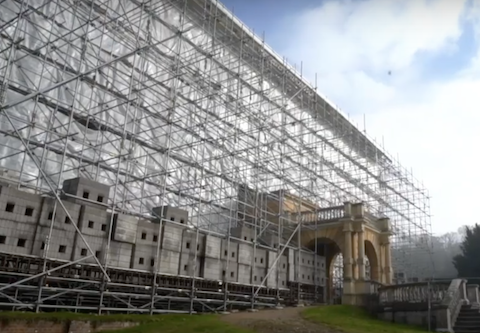
Images of Clandon Park house from the National Trust’s new video on YouTube. Link details at the end of this story.
It says these will feature walkways and platforms for visitors to explore the interiors at different levels, alongside a new roof with terraces and roof lights illuminating the building’s dramatic spaces.
Visitors will be able to access the new roof and view the interior spaces of the house from above, as well as the surrounding countryside.
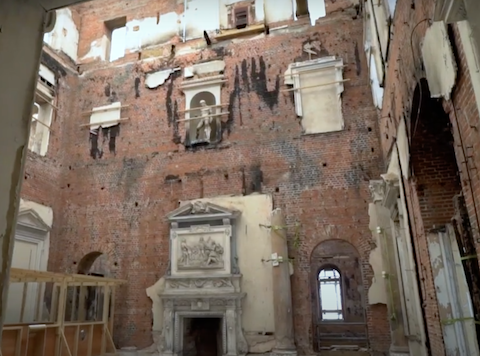 The fire was the most devastating in the National Trust’s history. It completely destroyed the roof, many of the internal walls and floors, along with much of the decorative interior, leaving a brick shell, open to the elements and filled with several feet of fire-damaged collections and building debris.
The fire was the most devastating in the National Trust’s history. It completely destroyed the roof, many of the internal walls and floors, along with much of the decorative interior, leaving a brick shell, open to the elements and filled with several feet of fire-damaged collections and building debris.
The National Trust says that Immediately after the fire, work had to focus on protecting and stabilising the building and painstakingly salvaging damaged collections and building material.
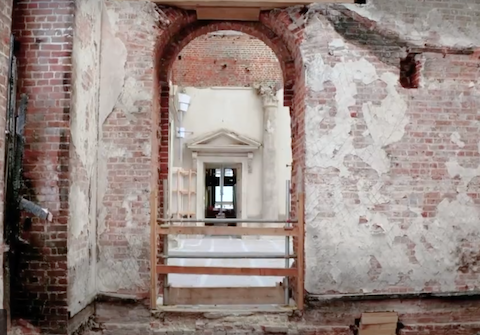 Specialist research and conservation has revealed more and more about how the house was designed, constructed and decorated.
Specialist research and conservation has revealed more and more about how the house was designed, constructed and decorated.
Project director Kent Rawlinson said: “Since the fire, curators, archaeologists, craftspeople and other specialists have learnt so much about and from Clandon.
 “We’ve welcomed over 70,000 people, and their responses have shown us how powerful and exciting Clandon is today. It’s such an evocative, unusual place, and people respond to it in so many ways. We’ve had artists, scientists, engineers, designers, tradespeople, young children, all gasping in awe.
“We’ve welcomed over 70,000 people, and their responses have shown us how powerful and exciting Clandon is today. It’s such an evocative, unusual place, and people respond to it in so many ways. We’ve had artists, scientists, engineers, designers, tradespeople, young children, all gasping in awe.
“Clandon Park remains a great house today, physically laid bare and stripped back to its skeleton-like core. The trust’s plans for Clandon are grounded in respect for the house’s history and design.
“They give Clandon a distinct purpose for the future, as a place to explore its architectural spaces, as well as the craft skills and people who made this and similar great houses across the country.”
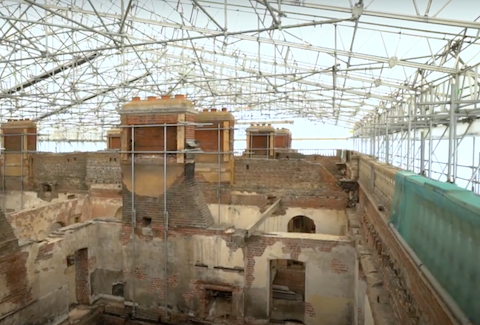 The National Trust adds that infrastructure will give the house’s interior a new lease of life, enabling events, displays, and creative uses of the space, including re-display of saved collections.
The National Trust adds that infrastructure will give the house’s interior a new lease of life, enabling events, displays, and creative uses of the space, including re-display of saved collections.
Approximately 600 items from the original collection were saved from the house during the fire, including paintings, furniture, ceramics, and textiles.
It says a creative approach will be taken to displaying these within the house, using them to illuminate craft and art processes, their skilled makers and to tell stories of the many people who lived and worked at Clandon.
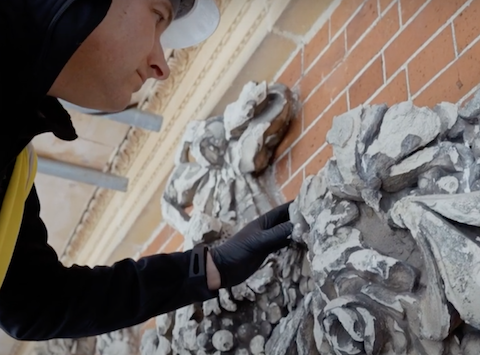 Craftspeople are repairing the exterior of the house – its historic brickwork, arches and doorways – in what is itself one of the National Trust’s largest ever conservation projects.
Craftspeople are repairing the exterior of the house – its historic brickwork, arches and doorways – in what is itself one of the National Trust’s largest ever conservation projects.
It has moved away from earlier plans to restore some ground floor rooms. These will now be conserved and curated in their laid-bare condition, except the one space that survived the fire, the Speakers’ Parlour.
The National Trust has completed initial feasibility work for the new approach and detailed designs will now be developed by architects Allies & Morrison for planning and statutory approvals. The conservation and repair of the brick and stone shell will continue in parallel.
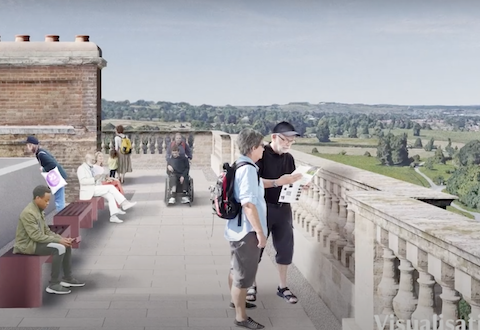 The National Trust estimates the whole project will be completed by late 2027-28, depending on the duration of the construction programme.
The National Trust estimates the whole project will be completed by late 2027-28, depending on the duration of the construction programme.
Click here to view the National Trust video on YouTube New plans for Clandon Park embrace a great house laid bare.
Responses to National Trust’s Plans For Clandon Park: ‘A Great House Laid Bare’
Leave a Comment Cancel replyPlease see our comments policy. All comments are moderated and may take time to appear.
Recent Articles
- Guildford Institute’s Crowdfunding Project for Accessible Toilet in its New Community and Wellbeing Centre
- Letter: Guildford – Another Opportunity Missed?
- Letter: GBC’s Corporate Strategy – Where Is the Ambition?
- My Memories of John Mayall at a Ground-breaking Gig in Guildford Nearly Six Decades Ago
- Westborough HMO Plans ‘Losing the Heart of the Street’ Says Resident
- College Invests to Boost Surrey’s Economy and Close Digital Skills Gap
- Community Lottery Brings Big Wins for Local Charities
- GBC Housing Plan Promises ‘A Vibrant Urban Neighbourhood’ Near Town Centre
- Hospital Pillows ‘Shortage’ at the Royal Surrey
- Updated: Caravans Set Up Camp at Ash Manor School


Recent Comments
- Ian Macpherson on Updated: Main Guildford to Godalming Road Closed Until August 1
- Sara Tokunaga on GBC Housing Plan Promises ‘A Vibrant Urban Neighbourhood’ Near Town Centre
- Michael Courtnage on Daily Mail Online Reports Guildford Has Highest-paid Council Officer
- Alan Judge on GBC Housing Plan Promises ‘A Vibrant Urban Neighbourhood’ Near Town Centre
- John Perkins on GBC Housing Plan Promises ‘A Vibrant Urban Neighbourhood’ Near Town Centre
- S Collins on GBC Housing Plan Promises ‘A Vibrant Urban Neighbourhood’ Near Town Centre
Search in Site
Media Gallery
Dragon Interview: Local Artist Leaves Her Mark At One of England’s Most Historic Buildings
January 21, 2023 / No Comment / Read MoreDragon Interview: Lib Dem Planning Chair: ‘Current Policy Doesn’t Work for Local People’
January 19, 2023 / No Comment / Read MoreA3 Tunnel in Guildford ‘Necessary’ for New Homes, Says Guildford’s MP
January 10, 2023 / No Comment / Read More‘Madness’ for London Road Scheme to Go Ahead Against ‘Huge Opposition’, Says SCC Leader
January 6, 2023 / No Comment / Read MoreCouncillor’s Son Starts Campaign for More Consultation on North Street Plan
December 30, 2022 / No Comment / Read MoreCounty Council Climbs Down Over London Road Works – Further ‘Engagement’ Period Announced
December 14, 2022 / No Comment / Read MoreDragon Interview: GBC Reaction to the Government’s Expected Decision to Relax Housing Targets
December 7, 2022 / No Comment / Read MoreHow Can Our Town Centre Businesses Recover? Watch the Shop Front Debate
May 18, 2020 / No Comment / Read More









Patrick Streeter
April 26, 2024 at 12:28 pm
Clandon House should be restored to original condition. The National Trust have the money and they have done this to other houses.
Valerie Thompson
April 26, 2024 at 3:21 pm
Clandon House was well insured and the National Trust was paid out after the fire. I agree that the house should be restored, even if most of the contents were lost. It could surely be furnished in a similar style with either items in store or purchased specially for the rooms. In fact it could be made even better than before as the upstairs was only partially furnished.
The National Trust has lost its way regarding the conservation of houses left to them or which have partly been paid for by the organisation, with items removed, notices indicating irrelevant slavery connections, an emphasis on LGBT links etc.
Restore Trust, an organisation set up to return the National Trust to its former policies, has failed to get any of their members appointed to the board or their ideas adopted as the NT instituted a method of voting which was designed to allow only their chosen candidates to be selected.
Beth Moore
April 26, 2024 at 11:01 pm
Wow, this is so interesting. I’ve been around so many stately homes and this will be something a bit different. Looking forward to visiting eventually.
Stuart Barnes
April 27, 2024 at 9:43 am
Of course Clandon House should be put back as near as possible to the way that it was before the fire.
Anthony Mallard
April 27, 2024 at 10:06 am
Clandon House has now sadly remained shrouded in scaffolding for nine years. Whilst the house and contents may have been insured, it is possible, I surmise, that the cost of the scaffolding and making the structure safe for all these years has been set against the insurance pay-out. There may be little money left.
We have heard, since the fire, about many schemes for its future, by way of restoration, often dismissed as a pastiche, retention of some parts, such as the Speakers Parlour and a new approach highlighting the “bones” of the house’s construction.
What we don’t know is a definitive start date. A completion date was indicated as 2027/8 That’s perilously close for such a big project even if it were to begin soon.
I believe this completion date was indicated in 2022, plans may have changed. Local people and members of the National Trust just don’t know. This historic building, one of few designed by Giacomo Leoni in the 18th Century deserves better but its future appears to be moribund whilst the National Trust remains silent. Why?